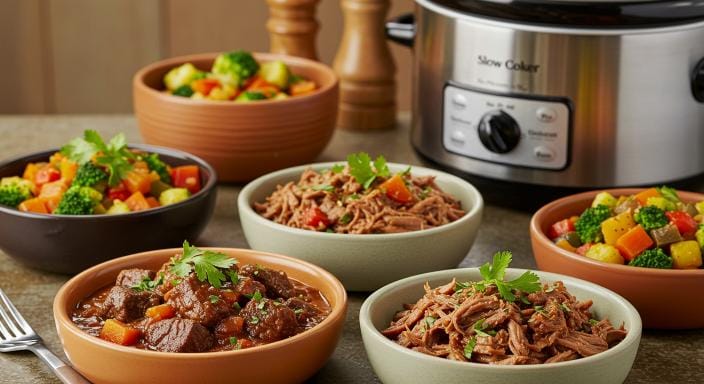Introduction:
Imagine the enticing aroma of spices wafting through your home, the cozy warmth of a hearty meal awaiting you after a long day, and the ease of a cooking method that requires minimal effort. This is the allure of slow cooker dinner recipes. In our fast-paced world, where time is often scarce, slow cookers have become culinary heroes, turning ordinary evenings into delightful culinary experiences.
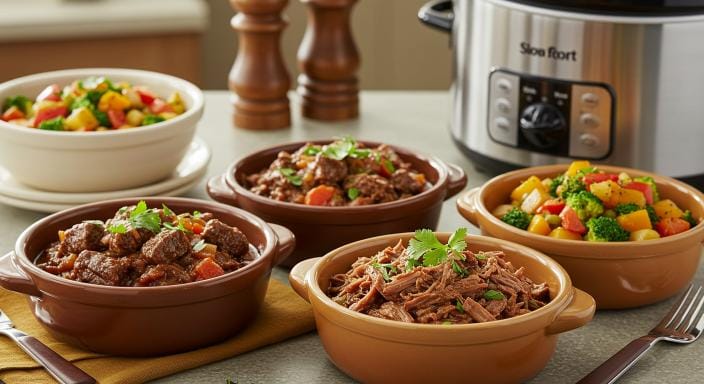
Instead of rushing through dinner prep, envision the savory scent of a perfectly braised stew or tender pulled pork welcoming you at the end of your day. In this article, we’ll explore the art of slow cooking, revealing its secrets and offering you a treasure trove of flavorful, effortless dinner recipes. Get ready to discover how simple and rewarding slow cooking can be!
Key Aspects of Slow Cooker Dinner Recipes:
The popularity of slow cooker dinner recipes reflects a broader cultural shift towards convenience and healthier eating. The beauty of slow cooking lies in its ability to transform tough cuts of meat into tender delights, infuse flavors deeply into vegetables, and create rich, satisfying broths—all while requiring minimal effort from the cook. Think of it as a form of culinary magic that turns humble ingredients into extraordinary meals with just a few straightforward steps.
The rise of the slow cooker is not merely a passing trend; it’s a response to our busy lifestyles. Many households now own a slow cooker, underscoring its widespread appeal. This is hardly surprising, given its numerous advantages:
- Time-saving: With minimal prep time, the slow cooker takes care of the cooking, allowing you to focus on other tasks or simply unwind while dinner prepares itself. This is especially beneficial for busy parents and professionals.
- Flavor enhancement: The slow cooking process melds flavors beautifully, resulting in dishes that are richer and more nuanced than those cooked quickly. Imagine the deep, savory notes of a slow-cooked beef stew, unfolding with every spoonful.
- Energy efficiency: Slow cookers use less electricity than conventional ovens, making them a cost-effective and environmentally friendly option.
- Versatility: From hearty stews and succulent roasts to delicate soups and even desserts, slow cookers can handle a wide variety of dishes. The range of recipes—from classic comfort food to international cuisine—makes slow cooking an exciting culinary adventure.
Beyond their practical benefits, slow cooker recipes evoke nostalgia and foster family connections. Many people associate slow cooker meals with warm memories of family gatherings and cherished traditions. The act of slow cooking can be almost meditative; the gentle bubbling and simmering create a soothing soundscape that enhances the overall experience, turning cooking into a mindful journey filled with flavors and shared moments. These recipes are not just meals; they are stories waiting to be shared and enjoyed together.
Ingredients You’ll Need for Slow Cooker Dinner Recipes
The charm of slow cooker recipes lies in their simplicity. You don’t need an extensive pantry filled with exotic ingredients; a few staple items can create culinary magic. While the exact ingredients will vary depending on the specific recipe—like a hearty beef stew versus a light chicken and vegetable dish—certain common ingredients form the foundation of many successful slow cooker meals.

Picture the rich aroma of a slow-cooked dish, with tender meat falling apart at the slightest touch. To achieve this, consider the following essentials:
- Protein: This is the centerpiece of your dish! Options include succulent beef chuck roasts, tender chicken breasts, lean pork shoulder, or hearty lentils for a vegetarian alternative. The choices are as diverse as your culinary imagination.
- Vegetables: The vibrant colors and textures of vegetables add depth and nutrition. Onions, carrots, and celery create a classic mirepoix, forming a flavorful base for countless slow cooker recipes. However, don’t hesitate to include other vegetables like potatoes, peppers, zucchini, and tomatoes for added variety.
- Liquids: Broth (beef, chicken, or vegetable), wine (red or white), or even simple water keeps the ingredients moist and prevents burning. The liquid also infuses the meat and vegetables with flavor, creating a harmonious blend of tastes.
- Seasonings: A pinch of salt and pepper is essential, but feel free to experiment! Garlic powder, onion powder, paprika, cumin, and chili powder can elevate a simple dish into a culinary masterpiece. Fresh herbs like rosemary, thyme, or oregano add another layer of aromatic complexity.
- Optional additions: Depending on your chosen recipe, you might incorporate ingredients such as beans, grains (like rice or barley), or a splash of Worcestershire sauce for added depth of flavor.
Flexibility is key—adapt these suggestions to fit the specific slow cooker recipes you choose. The joy lies in the creative process!
Step-by-Step Instructions to Make Slow Cooker Dinner Recipes
Slow cooker recipes are synonymous with ease and convenience, making them perfect for busy weeknights or leisurely weekends. Let’s embark on a culinary journey, step-by-step, to create a delicious slow-cooked masterpiece.
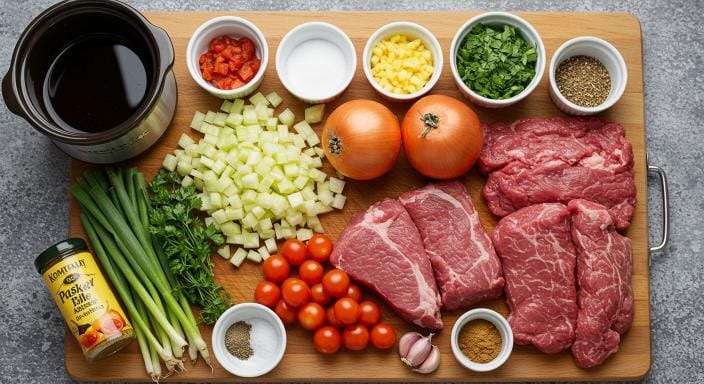
Step 1: Preparation is Key (Like a symphony’s overture):
Before you even think about turning on your slow cooker, prepare your ingredients. Chop your vegetables into roughly equal-sized pieces to ensure even cooking. This step is akin to a painter preparing their canvas; the better the preparation, the more stunning the final result. If you choose to brown your meat (optional but recommended), do so in a pan before adding it to the slow cooker. Think of this browning as the crescendo of the preparation, building anticipation for the main act.
Step 2: Layering the Flavors (A culinary tapestry):
Layer your ingredients in the slow cooker. Start with the aromatics—onions, garlic, and herbs—to create a fragrant base. Next, add your meat, followed by the vegetables. Think of this as arranging jewels on a velvet cloth; each ingredient contributes to the overall beauty and complexity.
Step 3: Adding the Liquid (The lifeblood of the dish):
Pour your chosen liquid—broth, wine, or water—over the ingredients, ensuring they are mostly submerged. The liquid is the lifeblood of your dish, providing moisture and allowing the flavors to meld seamlessly.
Step 4: Seasoning with Love (The conductor’s baton):
Season generously with salt, pepper, and your chosen spices. Be mindful not to over-season; taste as you go, adjusting the seasoning to your preference. This step is where you, the chef, act as the conductor, orchestrating a balanced and harmonious blend of flavors.
Step 5: Slow Cooking Magic (The gentle simmer):
Set your slow cooker to low or high, depending on your recipe instructions and available time. Low settings generally require longer cooking times, resulting in incredibly tender meat and deeply infused flavors. Imagine the gentle simmer, a soothing rhythm coaxing out the best from each ingredient.
Step 6: Checking for Doneness (The anticipation builds):
Check your dish periodically, especially toward the end of the cooking time, to ensure the meat is tender and the vegetables are cooked through. The anticipation builds as you peek into the slow cooker, the aroma growing stronger with every passing moment.
Step 7: The Grand Finale (Serving with style):
Once cooked, let the slow cooker dish rest for a few minutes before serving. Garnish with fresh herbs or a dollop of sour cream or yogurt, adding a final touch of elegance to your culinary masterpiece. Serve hot and enjoy the fruits of your labor. The rich flavors and tender textures will surely impress your family and friends. Always follow specific recipe instructions, as cooking times and methods can vary considerably.
Nutritional Value of Ingredients in Slow Cooker Dinner Recipes
Slow cooker meals offer a fantastic opportunity to incorporate a variety of nutritious ingredients. The nutritional profile varies greatly depending on the specific recipe, but let’s examine some common components and their health benefits:
| Ingredient | Nutritional Benefits |
|---|---|
| Chicken Breast | Excellent source of lean protein, crucial for muscle building and repair. Rich in niacin and vitamin B6. |
| Beef (Lean Cuts) | Good source of iron, zinc, and B vitamins. Choose lean cuts to minimize saturated fat intake. |
| Pork Tenderloin | Provides thiamin, niacin, and vitamin B6. Opt for lean cuts for a healthier option. |
| Beans (Kidney, Black) | Excellent source of fiber, promoting digestive health and lowering cholesterol. Rich in iron and folate. |
| Lentils | High in fiber and protein, contributing to satiety and blood sugar control. Good source of iron and folate. |
| Sweet Potatoes | Rich in beta-carotene (converted to vitamin A), promoting eye health and immune function. Excellent source of fiber. |
| Brown Rice | Provides complex carbohydrates for sustained energy, along with fiber and magnesium. |
| Broccoli | Excellent source of vitamin C and fiber, promoting immune function and digestive health. |
| Carrots | Good source of beta-carotene (vitamin A), fiber, and antioxidants. |
| Onions | Contain quercetin, a powerful antioxidant with anti-inflammatory properties. |
These are just a few examples; the possibilities are endless! Remember to balance your slow cooker recipes with a variety of colorful vegetables and lean protein sources for optimal nutritional value. The beauty of slow cooking is that it allows you to gently coax out the flavors and nutrients from your ingredients, resulting in delicious and healthy meals.
Benefits of Slow Cooker Dinner Recipes
Slow cooker recipes are a culinary revelation, transforming busy weeknights into moments of effortless deliciousness. Imagine the aroma of a rich stew simmering gently, filling your home with warmth and the promise of a comforting meal. This isn’t just about convenience; it’s about unlocking a world of flavor and health benefits.
Firstly, slow cookers are incredibly time-efficient. You simply toss in your ingredients in the morning, and by evening, a perfectly cooked meal awaits. This frees up precious time, allowing you to focus on other priorities or simply relax and enjoy your evening. I recall one particularly hectic week when a slow-cooked chicken and vegetable curry was my saving grace—a nourishing, flavorful meal ready without any fuss.
Secondly, slow cooking enhances flavor. The long, gentle cooking process allows the ingredients to meld together, creating a depth of flavor impossible to achieve with quicker cooking methods. The flavors are like a symphony, each note harmonizing beautifully with the others. Think of the rich, tender texture of a slow-cooked pot roast, falling apart at the mere touch of a fork—a testament to the magic of slow cooking.
Thirdly, slow cookers are incredibly versatile. From hearty stews and soups to succulent meats and flavorful desserts, the possibilities are endless. They accommodate a diverse range of recipes, catering to various tastes and preferences. This adaptability makes them an invaluable asset in any kitchen, a culinary chameleon ready to tackle any culinary challenge.
Overcoming Challenges with Slow Cooker Dinner Recipes
While slow cookers offer unparalleled convenience, a few common hurdles might arise. Let’s address them proactively:
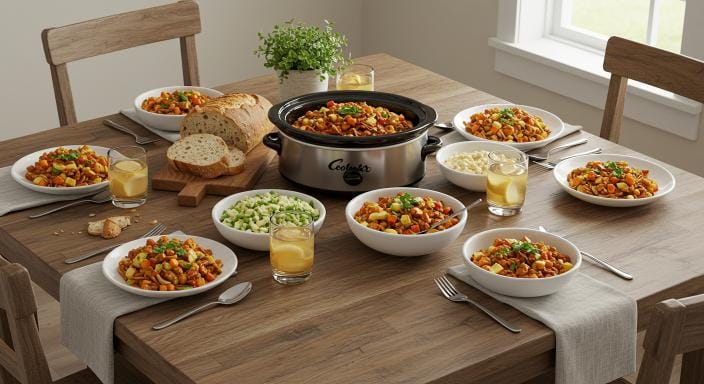
1. Overcooked or Tough Meat: The key is to select the appropriate cut of meat. Tougher cuts benefit most from slow cooking, becoming incredibly tender. Leaner cuts, however, might dry out. If using leaner meats, add a bit of broth or liquid to prevent dryness.
2. Inconsistent Cooking: Ensure your ingredients are evenly distributed within the slow cooker. Avoid overcrowding; leave some space for even heat circulation. Using a slow cooker liner can also prevent sticking and uneven cooking.
3. Bland Flavors: Don’t be shy with seasonings! Experiment with herbs, spices, and aromatics to enhance the flavors. A touch of acidity, like lemon juice or vinegar, can also brighten up the dish. Taste and adjust seasonings throughout the cooking process for optimal flavor.
4. Burning: Always ensure there’s sufficient liquid in the slow cooker to prevent burning. If using a recipe that calls for little liquid, monitor closely and add more as needed.
5. Cleaning: Use a slow cooker liner for easier cleaning. Soak the pot in warm, soapy water after use for easy removal of stubborn residue. Avoid abrasive cleaners that can scratch the non-stick surface.
Future Trends in Slow Cooker Dinner Recipes
The slow cooker continues its reign as a kitchen essential, but exciting trends are shaping its future. We’re seeing a surge in:
- One-pot wonders: Recipes that emphasize minimal cleanup with complete meals prepared in a single slow cooker pot.
- Global cuisine adaptations: More recipes from diverse international cuisines are being adapted for slow cooking, offering exciting flavor profiles.
- Health-conscious options: A growing focus on healthy, whole-food ingredients, catering to dietary restrictions and wellness goals.
- Smart slow cookers: Technology integration, such as smartphone connectivity and pre-programmed settings, enhances convenience and precision.
- Meal prepping: Slow cookers are increasingly used for large-batch meal prepping, saving time and reducing food waste.
These trends reflect a growing demand for convenience, health, and culinary exploration, all perfectly met by the adaptable slow cooker. Embrace these trends for a more efficient and flavorful cooking experience.
Tips and Tricks for Slow Cooker Dinner Recipes
Mastering slow cooker recipes is an art, honed through experience and a few clever tricks. Here are some insider tips to elevate your culinary game:
- Sear meat first: Searing meat before slow cooking adds a rich, caramelized flavor that enhances the final dish. This simple step makes a world of difference.
- Layer ingredients: Start with aromatics at the bottom (onions, garlic), followed by tougher vegetables, then meats, and finally delicate ingredients. This ensures even cooking and prevents overcooking.
- Don’t overfill: Leave space for the ingredients to simmer and the steam to circulate. Overfilling can lead to uneven cooking and less tender results.
- Use liquid wisely: The right amount of liquid is crucial. Too much can make your dish watery, while too little might result in burnt or dry food. Follow recipes carefully, adjusting as needed based on your ingredients.
- Thicken sauces: A cornstarch slurry or a quick simmer at the end can thicken sauces for a richer consistency. Experiment with different thickening agents for varying textures.
These tips will significantly enhance your slow cooker recipes, taking them from good to unforgettable.
Variations and Adaptations for Slow Cooker Dinner Recipes
Slow cooking is incredibly versatile and can easily be tailored to various dietary needs. You can adapt your recipes to be:
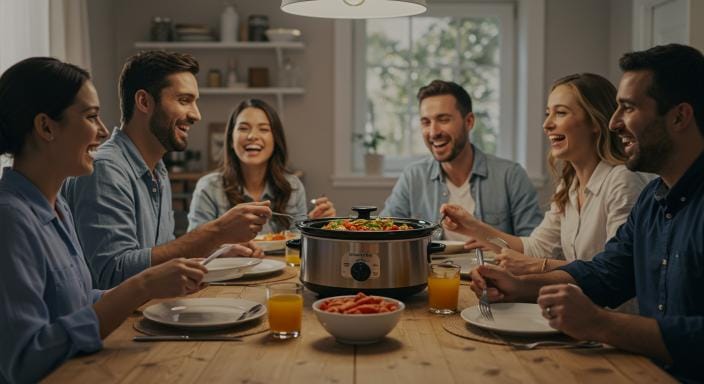
- Gluten-free: Ensure all ingredients (broth, sauces, etc.) are certified gluten-free. Substitute gluten-free breadcrumbs or alternative thickeners if needed.
- Vegetarian: Replace meat with hearty vegetables like mushrooms, lentils, beans, or tofu. Enhance flavor with rich broths and spices.
- Vegan: Use plant-based broth, avoid dairy products, and choose vegan-friendly ingredients. Many recipes can be adapted with simple ingredient swaps.
- Dairy-free: Substitute coconut milk, almond milk, or other dairy-free alternatives in place of cream or milk. Many recipes naturally exclude dairy.
- Low-sodium: Use low-sodium broth and reduce the amount of salt added. Spices and herbs can effectively enhance flavors without relying on excessive salt.
Remember to check labels carefully and adjust seasoning to accommodate any substitutions.
FAQs Regarding Slow Cooker Dinner Recipes
Q: Can I freeze slow cooker meals?
A: Yes, many slow cooker meals freeze well. Allow the meal to cool completely before storing it in airtight containers.
Q: What happens if I accidentally overcook my slow cooker meal?
A: Overcooked food is usually still safe to eat, but the texture may be less appealing. Try adding more liquid to revive it.
Q: Can I use different types of slow cookers interchangeably?
A: Generally yes, but recipes might need adjustments. Pay attention to cooking times and liquid amounts.
Q: What are some good slow cooker liner brands?
A: Many brands offer excellent liners. Choose one that fits your slow cooker snugly and is made from food-safe materials.
Q: Can I brown meat in the slow cooker?
A: It’s not recommended; browning meat is best done in a skillet before adding it to the slow cooker.
These FAQs address common concerns and provide guidance for a smoother slow-cooking experience.
Conclusion
Slow cooker dinner recipes represent a culinary triumph, blending convenience, flavor, and health into one delectable package. By understanding the nutritional benefits, mastering the techniques, and adapting to various dietary needs, you can unlock a world of culinary possibilities. Embrace the versatility of the slow cooker, allowing it to become your culinary confidant, transforming weeknights into moments of effortless enjoyment. Share your favorite slow cooker recipes and tips in the comments below! Don’t forget to subscribe for more culinary adventures.

